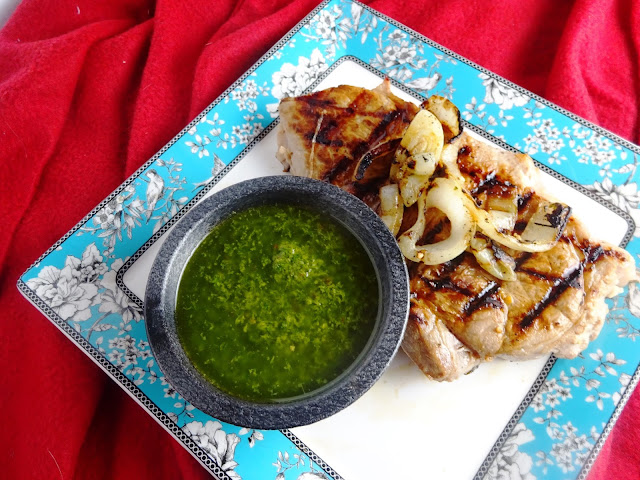Crispy Halibut in Tomato Bacon Ragu with Asparagus
Look at that picture above. As a friend noted, perhaps the best selling point of this recipe is that this is a crusty fish recipe with no added breading. This recipe comes straight out of the Thomas Keller Ad Hoc cookbook, a wonderful coffee table style cookbook with beautiful photographs to accompany the aspirational recipes. Which is not to say the recipes are difficult to make, so much as difficult on the wallet.
The first time I tried this recipe was years ago, when Josh made it for me for a fancy lunch. I readily admit that when I saw how much oil he used in the pan, I kind of scrunched my face at him. There must have been half an inch of cooking oil! Was he trying to deep fry this thing? Clearly mistakes had been made ... how much wine had we all been drinking?
But no, Josh was correct, the instructions were correct, and, despite the wine (or perhaps because of it), the fish ended up amazing! By cooking the hearty halibut in a deeper amount of oil, a thick crusty bottom forms, giving this dish a crunch to accompany the chunky tomato and bacon ragu.
Oh yeah! The ragu! This is the dish, the recipe, that taught me about rendering bacon. On the first cold day of this Autumn, I was immediately rendering bacon fat as a base for my all-day-chili! Rendering bacon fat is basically the perfect way to add that smoky cured deliciousness to anything. Here, it is infused with leeks and whole tomatoes, slowly cooked for an hour, then served over the fish and some chicken stock-cooked asparagus.
This is a recipe that takes time, but the rewards are incredibly worth it. Estimate about an hour and a half of prep and cooking, and don't expect any leftovers. In the odd event that you don't start spooning the ragu directly into your mouth, save it to serve over some eggs the next morning.
Or just go ahead and spoon it directly into your mouth.
Allow an hour and a half and a bottle of wine for cooking. Serves four.
Ingredients:
The first time I tried this recipe was years ago, when Josh made it for me for a fancy lunch. I readily admit that when I saw how much oil he used in the pan, I kind of scrunched my face at him. There must have been half an inch of cooking oil! Was he trying to deep fry this thing? Clearly mistakes had been made ... how much wine had we all been drinking?
But no, Josh was correct, the instructions were correct, and, despite the wine (or perhaps because of it), the fish ended up amazing! By cooking the hearty halibut in a deeper amount of oil, a thick crusty bottom forms, giving this dish a crunch to accompany the chunky tomato and bacon ragu.
Oh yeah! The ragu! This is the dish, the recipe, that taught me about rendering bacon. On the first cold day of this Autumn, I was immediately rendering bacon fat as a base for my all-day-chili! Rendering bacon fat is basically the perfect way to add that smoky cured deliciousness to anything. Here, it is infused with leeks and whole tomatoes, slowly cooked for an hour, then served over the fish and some chicken stock-cooked asparagus.
This is a recipe that takes time, but the rewards are incredibly worth it. Estimate about an hour and a half of prep and cooking, and don't expect any leftovers. In the odd event that you don't start spooning the ragu directly into your mouth, save it to serve over some eggs the next morning.
Or just go ahead and spoon it directly into your mouth.
Allow an hour and a half and a bottle of wine for cooking. Serves four.
Ingredients:
- 1.5-2 lbs fresh halibut, seasoned with salt and pepper
- Cooking oil (high heat) - enough to cover the bottom of your frying pan with 1/4-1/2 inch of oil
- 1/4 lb. uncooked bacon, chopped into 1/2 inch slivers
- water (will be added in Tbs to the rendering pan)
- 2 leeks, chopped into thin slivers
- 28 oz. can whole tomatoes
- 1 lb asparagus, hard stems removed
- 1 cup chicken stock
To Prepare:
- Open a bottle and pour yourself a healthy (read: large) glass of wine. Your heart will tell you to go white with the fish and all, but given the hearty, bacony nature of the dish, I actually recommend a lighter red.
- Preheat the oven to 400 degrees.
- In a large frying pan, add your chopped raw bacon and 2 Tbs water. Turn on the burner to low, and slowly stir the bacon around. The water should heat up and begin to soak the fat from the bacon, creating an oil on the bottom of the pan. If the water begins to get too scarce or too oily before the bacon is fully rendered, add another tablespoon of water. At times making this dish, I have used upwards of 6 tablespoons of water, yet aon other occasions used only the original 2. The key here is the keep the heat low and do not let the bacon crisp up. The bacon has been rendered enough when the fatty sections have reduced by half and the pink parts are beginning to darken to a red. Remove the bacon with a slotted spoon, keeping behind all of the rendered fat. Rendering should take 20-30 minutes over a very low heat.
- Turn the heat up to medium and add your chopped leeks. Toss to coat them in the bacon fat, then slowly sweat the leeks for 3-5 minutes until they soften. Add the tomatoes, juice and all, and carefully break them apart with the back of your wooden spoon. Turn the heat to low, and slowly simmer the entire sauce for 45 minutes, continuing to break the tomatoes into smaller pieces as they soften and stew.
- Add the bacon to the sauce, stirring in to incorporate. Let the sauce cook on low heat for another ten minutes. Once finished, turn off and set aside.
- As the sauce finishes, add enough cooking oil to a steep-sided, oven-safe cooking pan (preferably cast iron) to have between 1/4 to 1/2 inch of oil on the base. Heat the oil on high heat until the surface shimmers, then add your fish, prettiest side up. Let the fish rest in the oil for 4-6 minutes until a thick, golden crust has formed. Place the entire pan into the oven for 5 minutes to finish cooking the fish.
- While the fish is browning to a crust, in a large pan on high heat, add your chicken stock. Once simmering, add the asparagus. Cook until the asparagus is bright green and soften slightly, approximately 5 minutes. Remove the asparagus from the remaining stock.
- With the asparagus and sauce done, now to finish the fish! Pull the pan out of the oven and put back on the stovetop. No need to add heat, as the oil is still incredibly hot from the oven. Flip each piece of fish, "kissing" the pretty side to the oil for 30 seconds, then removing to the plate.
- Plate however you like. I prefer the fish with asparagus on top, then smothered in the ragu. Feel free to keep things separated.
Et voila! Bon appetit!












You are amazing and inspiring. This may be a special dinner for Greg and me. You rock dude!
ReplyDelete